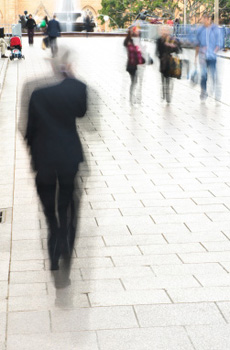Sleepwalking Disorder
Sleepwalking, also called somnambulism, occurs when a person performs motor activities during sleep, which can be sleepwalking disorder. Sleepwalking activities are not limited to walking but can include a wide array of activities such as driving, cooking meals, flailing limbs, or sitting upright in bed, amongst many others. While sleepwalking can be a concern for many, it is not considered a disorder unless it causes significant impairment or distress to the person.
How is Sleepwalking Disorder Diagnosed?
Sleepwalking disorder is a type of parasomnia sleep disorder defined by the Diagnostic and Statistical Manual of Mental Health Disorders fourth Edition (DSM IV).
You must meet the following criterion to be diagnosed with a sleepwalking disorder:
- Sleepwalking episodes occur repeatedly. Sleepwalking involves getting out of bed while still asleep and most frequently occurs in the first third of the sleep cycle.
- During the sleepwalking episodes, you must be unresponsive, have a blank facial expression and cannot be awakened easily.
- Once awake, you do not recall the sleepwalking episode.
- Once awake,you return to normal cognitive functioning within a few minutes.
- The sleepwalking episodes are not caused by external factors such as drugs or a medical problem.
- The sleepwalking episodes cause significant impairments or distresses to functioning, such as socially or at work.
The final requirement listed here is the most important to differentiate between sleepwalking and a sleepwalking disorder. In children, it can be especially difficult to diagnose sleepwalking disorder as the episodes don’t usually cause the child any distress or impairment – though they may cause distress to those around the child, such as the parents.
Diagnosing sleepwalking disorder can be difficult because physicians must be able to monitor the symptoms. To do this, physicians may perform a polysomnography – a test which monitors brain and other bodily activity during sleep.
How Common is Sleepwalking Disorder?
 Sleepwalking itself is very common, particularly amongst children but it is not uncommon for adults to also have episodes of sleepwalking. Sleepwalking most commonly first occurs between the 4 to 8 years of age when about 20% will experience episodes. In school-aged children, sleepwalking is more common in boys than in girls. Childhood sleepwalking also often occurs with bed wetting. In adults, sleepwalking incidences are less common than with children but about 2.5% of adults will sleepwalk.
Sleepwalking itself is very common, particularly amongst children but it is not uncommon for adults to also have episodes of sleepwalking. Sleepwalking most commonly first occurs between the 4 to 8 years of age when about 20% will experience episodes. In school-aged children, sleepwalking is more common in boys than in girls. Childhood sleepwalking also often occurs with bed wetting. In adults, sleepwalking incidences are less common than with children but about 2.5% of adults will sleepwalk.
Despite the commonness of sleepwalking in children, only about 1-5% of children meet the diagnostic criteria of sleepwalking disorder. Childhood sleepwalking can continue into adulthood as many adults with sleepwalking disorder had episodes during childhood. Only about 0.5% of adults meet the diagnostic criteria for a sleepwalking disorder.
What Causes Sleepwalking Disorder?
In polysomnography tests, experts have identified unusual brain activity associated with sleepwalking. One of the most widely-held beliefs about the cause of sleepwalking is immaturity in the central nervous system. Essentially, the development of the central nervous system has not caught up with the rest of the body and results in abnormal sleep behaviors. When the central nervous system matures, then the patient will typically outgrow the sleepwalking disorder.
Other factors can contribute to sleep walking such as fever (which can affect brain function), sleep deprivation, and fatigue. There is also a possible genetic component to sleepwalking disorder as many people diagnosed have a history of sleepwalking in their families.
What are the Risk Factors for Sleepwalking Disorder?
Sleepwalking disorder has an apparent genetic component. People who have parents who sleep walked are more likely to also sleepwalk. People who have psychiatric health disorders are also at a higher risk of adult-onset sleepwalking disorder.
How is Sleepwalking Disorder Treated?
Treatment for sleepwalking disorder is not always necessary, particularly in children where it is likely that they will outgrow the disorder. Often, the foremost concern for treating sleepwalking disorder is preventing any possible harm which could be caused by the sleep activities, such as by clearing clutter from the floor of the sleepwalker’s room, keeping doors locked, and securing windows shut. In adults, preventing possible harms from sleepwalking activities can be more complex – particularly if the adult is engaging in activities like sleep driving or preparing meals. In these cases, creative measures may be employed to reduce risk of harm – such as hiding car keys.
One of the most effective methods of preventing sleepwalking is waking the person before the sleepwalking episode begins. To do this, the activity of the sleepwalker must be analyzed until the regular time of the episode can be determined. Then the sleeper is awoken about 15 minutes before the episode is likely to begin and required to remain awake for a minimum of 5 minutes before going back to sleep. This method has proven very effective in children. It is also recommend that children be encouraged to empty their bladders before going to bed as a full bladder may trigger sleepwalking.
For severe cases of sleepwalking disorder, a doctor may prescribe medications such as sedatives, hypnotics or antidepressants. Behavioral therapy focusing on sleep hygiene can also help reduce sleepwalking episodes. If an underlying mental health condition is suspected of causing the sleepwalking disorder, then treatment may involve psychotherapy or other methods of treating this disorder.
References:
American Psychiatric Association. (2001). Diagnostic and statistical manual of mental disorders (4th ed.). Washington, D.C.
Bharadwaj, R. & Kumar, S. (2007). Somnambulism: Diagnosis and treatment. Indian Psychiatry, 49; 2: 123-125.
Guilleminault, C., Kirisoglu, C., Bao, G. & Arias, V. (2005). Adult chronic sleepwalking and its treatment based on polysomnaography. Brain: A Journal of Neurology, 128; 5: 1062-1069.





